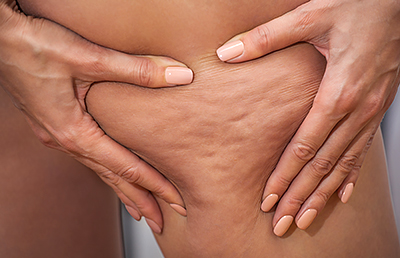
Cellulite is the bane of 80-90% of all women, but there is still an incredible amount of mystery surrounding the root cause. Where does it come from? And, just as importantly, how do we get rid of it?
So what is cellulite? Cellulite is dimpled, lumpy flesh that gives skin an uneven appearance and texture. While cellulite presents differently in some women, cellulite develops most commonly on the thighs and buttocks. The important thing to remember is that cellulite is perfectly naturally. If you’re a woman, you’re likely going to grapple with it at some point in your life. Cellulite is not indicative of a health problem, and it will not hurt you.
You should accept the inevitability of cellulite as part of the process of making peace with your own body. It is important to remember that the cultural distaste for cellulite is a result of archaic beauty standards. Cellulite is a natural bodily function!
That said, part of body positivity and autonomy is being able to change what you want about your body without feeling compelled to do so. If you feel good about your body but still want to take action to get rid of pesky cellulite for whatever reason, that is your prerogative!
But before you fix the problem, you should know how it happens.
How Cellulite is Created
Cellulite is the bulging of fat through the layers of connective tissue in your skin. It is something that happens progressively over time. Women are disproportionately affected because of the distribution of fat which naturally occurs in their bodies, as women tend to carry more fat in their hips, thighs, and butts than men.
The exact processes which cause cellulite to accumulate are hard to pin down, but one thing is for certain: aging is one of the primary risk factors for determining who develops cellulite and when. Even people with perfect diets and rigid exercise regimes develop cellulite. Genetics also play a huge role in the development of cellulite. If the women in your immediate family have cellulite, you will likely develop it to the same degree of severity.
How to Treat Cellulite
When treating cellulite, it is important to remember that it is a process which takes place entirely beneath several thick layers of skin. Keep this in mind when you’re evaluating the latest and greatest trendy cellulite cream. Because cellulite is entirely subdermal, you won’t see much success with topical treatments. Likewise, a good, balanced diet should be a priority, but it won’t have a marked effect on your cellulite.
If you’re committed to an over-the-counter treatment, you can try therapies which stimulate bloodflow to the region affected by cellulite. Things such as dry brushing the skin help promote collagen production and lymphatic drainage. (There are even topical creams which claim to yield similar results, but you should be more skeptical of those.)
There are a variety of laser treatments that claim to do the job of clearing up cellulite. There are even treatments that utilize radio frequencies. There are so many available therapies that it is wise to consult with an independent dermatologist and patients who are knowledgeable in procedures you’re considering before committing to any.
Endermologie is a promising candidate for those looking for effective cellulite therapies. So what is endermologie, anyway? Endermologie is a non-surgical treatment. It has no downtime and no side effects. Originally developed as a means of reducing the appearance of scar tissue, endermologie is essentially a targeted massage taking place over multiple sessions. It is an FDA-cleared treatment for cellulite.
Liposuction has long been touted as a solution to cellulite. However, there is reason to believe that liposuction can actually increase your cellulite woes over time. There is evidence suggesting that liposuction makes fat distribution in affected areas even more uneven and further degrades the appearance of skin in the region. Yuck!
There are some minimally invasive procedures your dermatologist can perform that essentially sever the connective tissue which is creating the bulges. This releases the pouches of fat to create a smoother appearance on the surface of the skin. Most patients report minimal downtime post-procedure.
Conclusion
Whether you’re considering treatments for the erasure of cellulite or simply preparing yourself for the inevitable, it cannot be repeated enough: cellulite is natural! There is nothing to be ashamed of when it comes to your body and its natural functions. That said, if you do decide to take the plunge and find an effective therapy, be sure to put in the time to research any so-called “miracle cures” that come your way.

